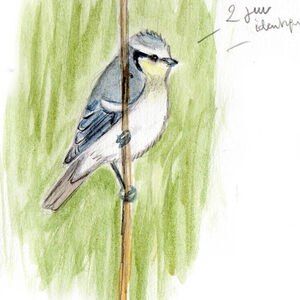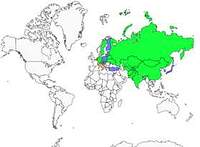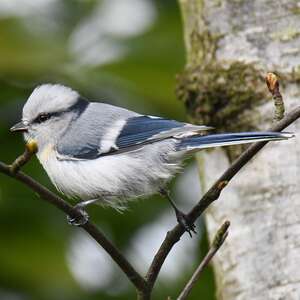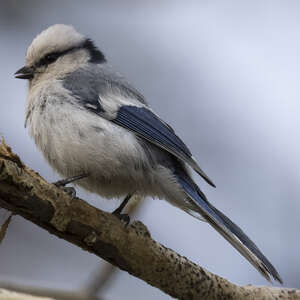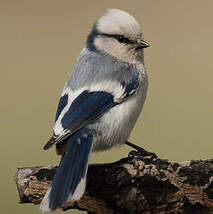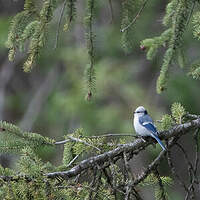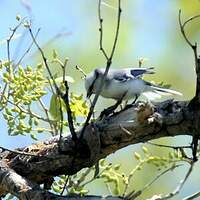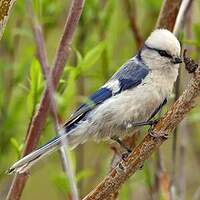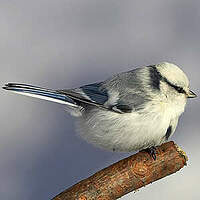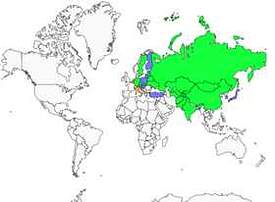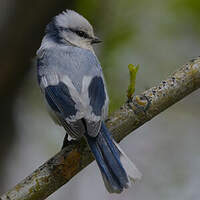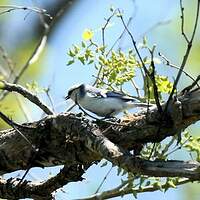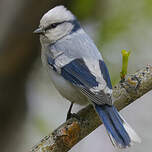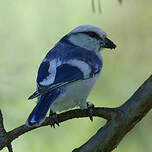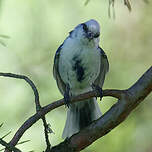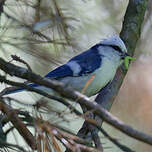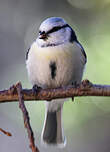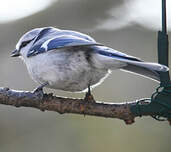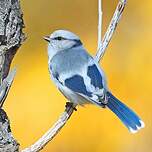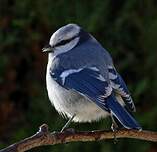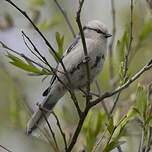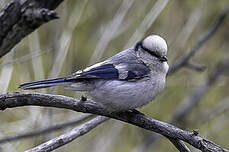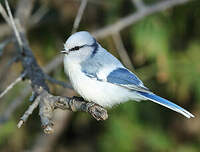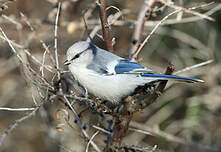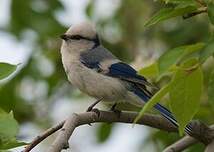Azure Tit
Cyanistes cyanus - Mésange azurée
Identification
The Azure Tit is the only one of its kind with a white crown. It is characterized by a black bar from the base of its beak to its neck, marked with a half-blue navy circle. The chest is white, with a faint black line. The legs and beak are black, and the eye is also black. The coat is rather fluffy, blue-gray, with a large white V visible on its wing, long tail bordered with white. Possible confusion with the Blue Tit, but the species' distribution does not allow for much error. On the young, the head and chest are grayish and the belly is yellowish. The adult's blue feathers are gray on the juveniles.
Subspecific information 8 subspecies
- Cyanistes cyanus cyanus (Belarus, w and c European Russia to c Ural Mts.)
- Cyanistes cyanus hyperrhiphaeus (sw Ural Mts., sw Siberia and n Kazakhstan)
- Cyanistes cyanus yenisseensis (sc to e Siberia, n Mongolia and ne China)
- Cyanistes cyanus tianschanicus (mountains of se Kazakhstan, Kyrgyzstan and nw China)
- Cyanistes cyanus koktalensis (lowlands of se Kazakhstan)
- Cyanistes cyanus carruthersi (Kyrgyzstan to n Tajikistan)
- Cyanistes cyanus flavipectus (s Kyrgyzstan to n Afghanistan)
- Cyanistes cyanus berezowskii (nc China)
Foreign names
- Mésange azurée,
- Herrerillo azul,
- chapim-de-cabeça-branca,
- Lasurmeise,
- lazúrcinege,
- Azuurmees,
- Cinciarella azzurra,
- azurmes,
- Asurmeis,
- sýkorka lazúrová,
- sýkora azurová,
- Azurmejse,
- valkopäätiainen,
- mallerenga capblanca,
- Hvítmeisa,
- sikora lazurowa,
- gaišzilā zīlīte,
- sinji plavček,
- Князёк,
- ルリガラ,
- 灰蓝山雀,
- azurmes,
- 灰藍山雀,
Voice song and call
Habitat
Behaviour character trait
It is a very active bird. It can sometimes hybridise with the Blue Tit, in which case it is called Parus pleskei. This hybridisation can also come from captive birds that manage to escape? Observations in Germany, France. It is sometimes found in flocks with Goldcrests (Regulus regulus) and/or warblers (Phylloscopus).
Dietfeeding habits
Reproduction nesting
Azure Tits can nest several tens of metres to several hundreds of metres away from each other. The nest is made of leaves, mosses, stems and various fibres. The breeding season starts at the end of March, beginning of April, with egg-laying from the beginning of April; about 10 white eggs with light red spots, incubated by the female for 13-14 days, is followed by a 20-day feeding period and fledging of the young in June.
Geographic range
Threats - protection
Sources of information
- IOC World Bird List (v14.2), Gill, F and D Donsker (Eds). 2024-04-18.
- Guide encyclopédique des oiseaux du Paléarctique occidental, Mark Beaman, Steve Madge
- Le guide ornitho : Le guide le plus complet des oiseaux d'Europe, d'Afrique du Nord et du Moyen-Orient : 900 espèces, Svensson, Mullarney, Zetterstrom
- Les passereaux d'Europe, tome 2, P. Géroudet, M. Cuisin
- Guide des oiseaux de France et d'Europe, Roger Tory Peterson, Guy Mountfort, P. A. D (Phill
- Avibase, Lepage Denis
- Handbook of the birds of the world Vol.14, josep del Hoyo
Other sources of interest
 Specification sheet created on
29/07/2023 by Anne et Gabriel Leboff
Specification sheet created on
29/07/2023 by Anne et Gabriel LeboffTranslation by AI Oiseaux.net
© 1996-2025 Oiseaux.net
- Accipitriformes
- Aegotheliformes
- Anseriformes
- Apodiformes
- Apterygiformes
- Bucerotiformes
- Caprimulgiformes
- Cariamiformes
- Casuariiformes
- Charadriiformes
- Ciconiiformes
- Coliiformes
- Columbiformes
- Coraciiformes
- Cuculiformes
- Eurypygiformes
- Falconiformes
- Galliformes
- Gaviiformes
- Gruiformes
- Leptosomiformes
- Mesitornithiformes
- Musophagiformes
- Nyctibiiformes
- Opisthocomiformes
- Otidiformes
- Passeriformes
- Pelecaniformes
- Phaethontiformes
- Phoenicopteriformes
- Piciformes
- Podargiformes
- Podicipediformes
- Procellariiformes
- Psittaciformes
- Pterocliformes
- Rheiformes
- Sphenisciformes
- Steatornithiformes
- Strigiformes
- Struthioniformes
- Suliformes
- Tinamiformes
- Trogoniformes

